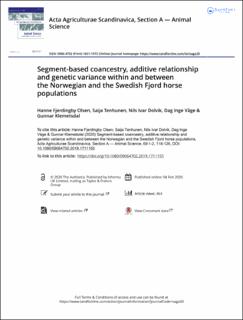| dc.contributor.author | Olsen, Hanne Fjerdingby | |
| dc.contributor.author | Tenhunen, Saija | |
| dc.contributor.author | Dolvik, Nils Ivar | |
| dc.contributor.author | Våge, Dag Inge | |
| dc.contributor.author | Klemetsdal, Gunnar | |
| dc.date.accessioned | 2020-07-09T08:08:21Z | |
| dc.date.available | 2020-07-09T08:08:21Z | |
| dc.date.created | 2020-02-27T14:39:02Z | |
| dc.date.issued | 2020 | |
| dc.identifier.citation | Acta agriculturae Scandinavica. Section A, Animal science. 2020, 69 (1-2), 118-126. | en_US |
| dc.identifier.issn | 0906-4702 | |
| dc.identifier.uri | https://hdl.handle.net/11250/2661538 | |
| dc.description.abstract | The Fjord horse originates from Norway but forms a global population due to several small populations in foreign countries. There exists no information about the additive relationship and the genetic variance between these subpopulations. By collecting blood samples from Norwegian and Swedish Fjord horses, a sample of 311 Norwegian and 102 Swedish horses gave 485,918 SNPs available for analysis. Their inbreeding coefficients were calculated and compared to the pairwise coancestry and the shared genomic segments. The effective population size was almost similar with the two methods in the Norwegian Fjord horse population (63 and 71), but very different in the Swedish population (269 and 1136) and unprecise due to a much smaller number of observations. The study showed that coancestry from shared genomic segments can be used to estimate additive genetic relationship and genetic variation within and between the global populations of the Fjord horse. | en_US |
| dc.language.iso | eng | en_US |
| dc.rights | Attribution-NonCommercial-NoDerivatives 4.0 Internasjonal | * |
| dc.rights.uri | http://creativecommons.org/licenses/by-nc-nd/4.0/deed.no | * |
| dc.title | Segment-based coancestry, additive relationship and genetic variance within and between the Norwegian and the Swedish Fjord horse populations | en_US |
| dc.type | Peer reviewed | en_US |
| dc.type | Journal article | en_US |
| dc.description.version | publishedVersion | en_US |
| dc.source.pagenumber | 118-126 | en_US |
| dc.source.volume | 69 | en_US |
| dc.source.journal | Acta agriculturae Scandinavica. Section A, Animal science | en_US |
| dc.source.issue | 1-2 | en_US |
| dc.identifier.doi | https://doi.org/10.1080/09064702.2019.1711155 | |
| dc.identifier.cristin | 1798173 | |
| dc.relation.project | Norges forskningsråd: 248339 | en_US |
| cristin.ispublished | true | |
| cristin.fulltext | original | |
| cristin.qualitycode | 1 | |

